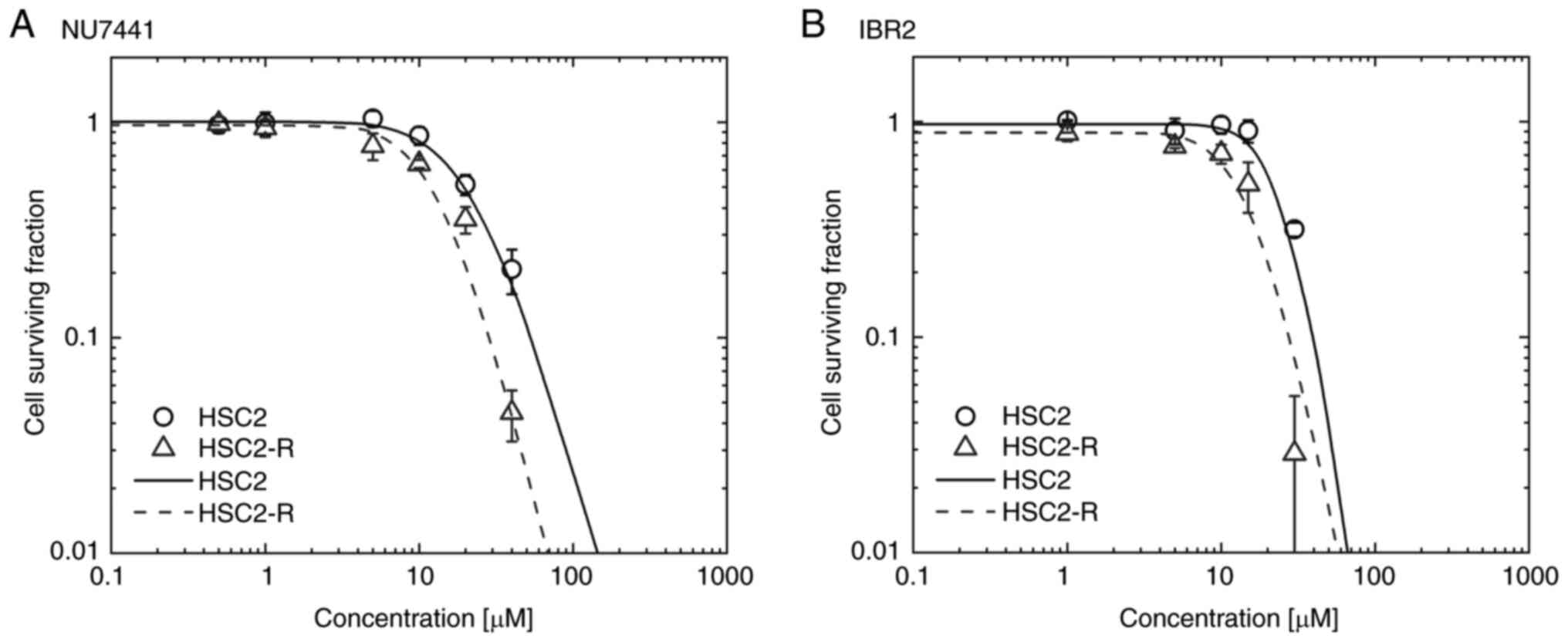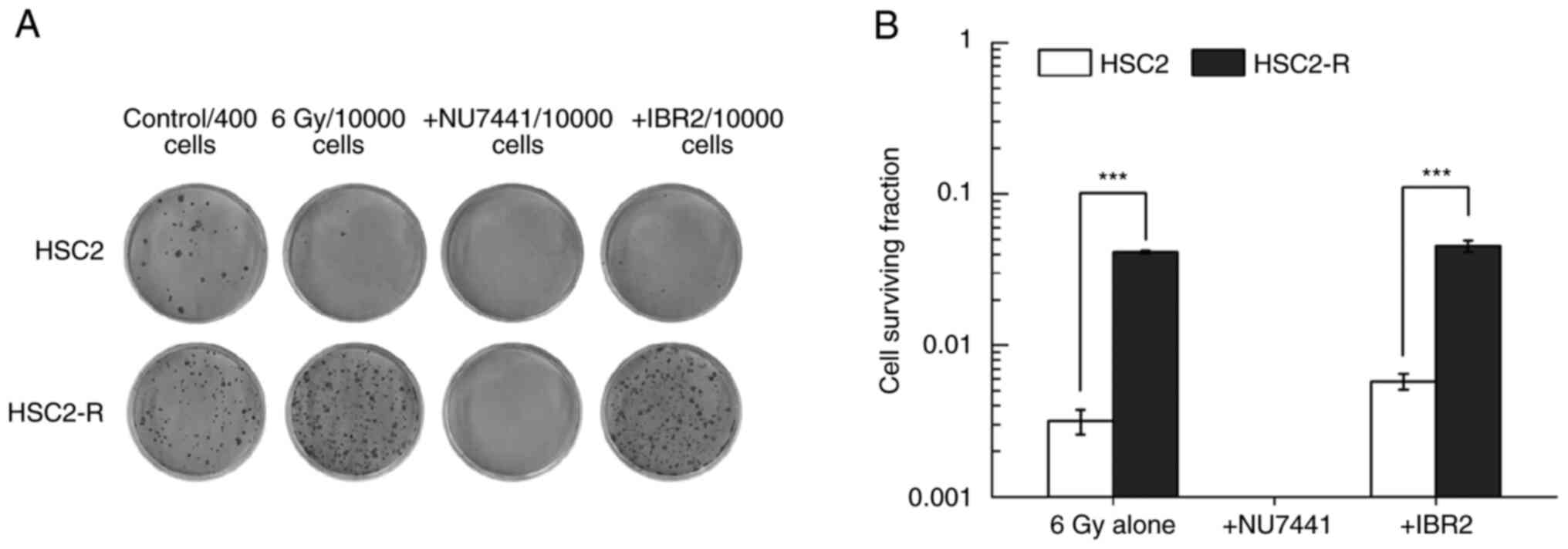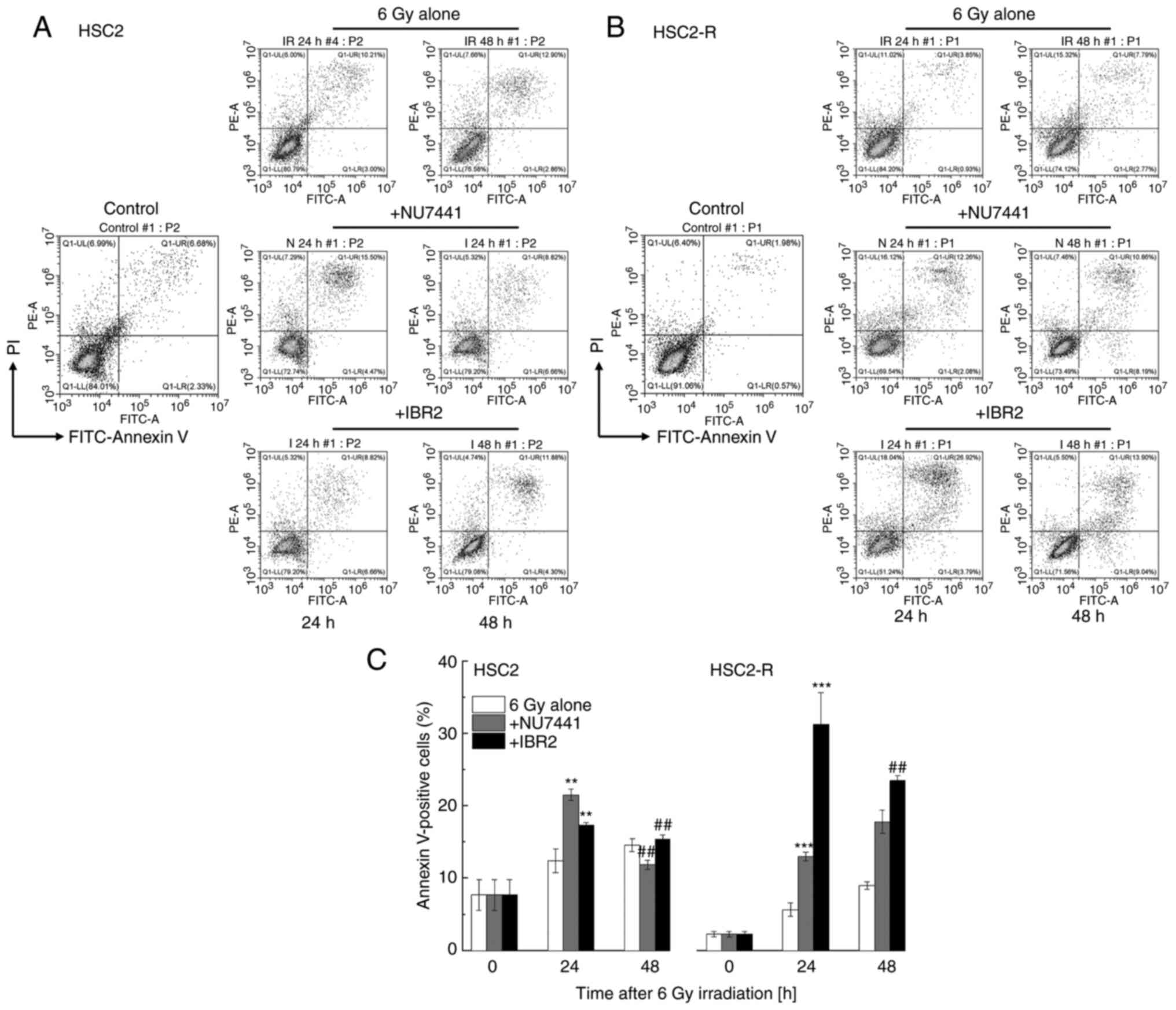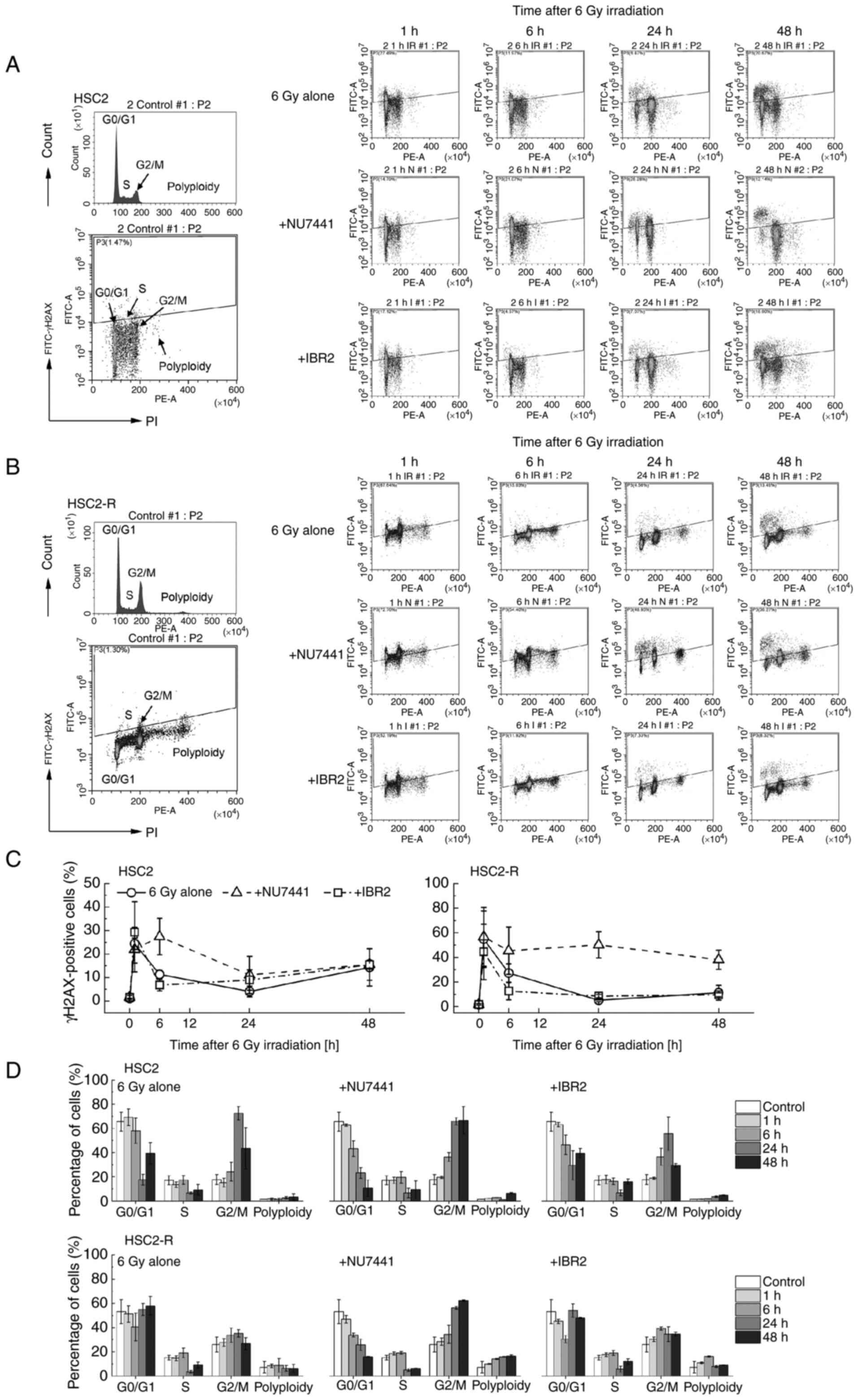|
1
|
Atun R, Jaffray DA, Barton MB, Bray F,
Baumann M, Vikram B, Hanna TP, Knaul FM, Lievens Y, Lui TY, et al:
Expanding global access to radiotherapy. Lancet Oncol.
16:1153–1186. 2015.PubMed/NCBI View Article : Google Scholar
|
|
2
|
Olivares-Urbano MA, Griñán-Lisón C,
Marchal JA and Núñez MI: CSC Radioresistance: A therapeutic
challenge to improve radiotherapy effectiveness in cancer. Cells.
9(1651)2020.PubMed/NCBI View Article : Google Scholar
|
|
3
|
Bajinskis A, Natarajan AT, Erixon K and
Harms-Ringdahl M: DNA double strand breaks induced by the indirect
effect of radiation are more efficiently repaired by non-homologous
end joining compared to homologous recombination repair. Mutat Res.
756:21–29. 2013.PubMed/NCBI View Article : Google Scholar
|
|
4
|
Vignard J, Mirey G and Salles B:
Ionizing-radiation induced DNA double strand breaks: A direct and
indirect lighting up. Radiother Oncol. 108:362–369. 2013.PubMed/NCBI View Article : Google Scholar
|
|
5
|
Hawkins RB and Inaniwa T: A
microdosimetric-kinetic model for cell killing by protracted
continuous irradiation including dependence on LET I: Repair in
cultured mammalian cells. Radiat Res. 180:584–594. 2013.PubMed/NCBI View Article : Google Scholar
|
|
6
|
Matsuya Y, McMahon SJ, Tsutsumi K, Sasaki
K, Okuyama G, Yoshii Y, Mori R, Oikawa J, Prise KM and Date H:
Investigation of dose-rate effects and cell-cycle distribution
under protracted exposure to ionizing radiation for various
dose-rates. Sci Rep. 8(8287)2018.PubMed/NCBI View Article : Google Scholar
|
|
7
|
Qi XS, Pajonk F, McCloskey S, Low DA,
Kupelian P, Steinberg M and Sheng K: Radioresistance of the breast
tumor is highly correlated to its level of cancer stem cell and its
clinical implication for breast irradiation. Radiother Oncol.
124:455–461. 2017.PubMed/NCBI View Article : Google Scholar
|
|
8
|
Matsuya Y, McMahon SJ, Butterworth KT,
Naijo S, Nara I, Yachi Y, Saga R, Ishikawa M, Sato T, Date H and
Prise KM: Oxygen enhancement ratios of cancer cells after exposure
to intensity modulated X-ray fields: DNA damage and cell survival.
Phys Med Biol. 66:2021.PubMed/NCBI View Article : Google Scholar
|
|
9
|
Kim RK, Suh Y, Cui YH, Hwang E, Lim EJ,
Yoo KC, Lee GH, Yi JM, Kang SG and Lee SJ: Fractionated
radiation-induced nitric oxide promotes expansion of glioma
stem-like cells. Cancer Sci. 104:1172–1177. 2013.PubMed/NCBI View Article : Google Scholar
|
|
10
|
Fukui R, Saga R, Matsuya Y, Tomita K,
Kuwahara Y, Ohuchi K, Sato T, Okumura K, Date H, Fukumoto M and
Hosokawa Y: Tumor radioresistance caused by radiation-induced
changes of stem-like cell content and sub-lethal damage repair
capability. Sci Rep. 12(1056)2022.PubMed/NCBI View Article : Google Scholar
|
|
11
|
Saga R, Matsuya Y, Takahashi R, Hasegawa
K, Date H and Hosokawa Y: Analysis of the high-dose-range
radioresistance of prostate cancer cells, including cancer stem
calls, based on a stochastic model. J Radiat Res. 60:298–307.
2019.PubMed/NCBI View Article : Google Scholar
|
|
12
|
Murata K, Saga R, Monzen S, Tsuruga E,
Hasegawa K and Hosokawa Y: Understanding the mechanism underlying
the acquisition of radioresistance in human prostate cancer cells.
Oncol Lett. 17:5830–5838. 2019.PubMed/NCBI View Article : Google Scholar
|
|
13
|
Shibata A: Regulation of repair pathway
choice at two-ended DNA double-strand breaks. Mutat Res.
803-805:51–55. 2017.PubMed/NCBI View Article : Google Scholar
|
|
14
|
Shibata A and Jeggo PA: DNA double-stand
break repair in a cellular context. Clin Oncol (R Coll Radiol).
26:243–249. 2014.PubMed/NCBI View Article : Google Scholar
|
|
15
|
Karanam K, Kafri R, Loewer A and Lahav G:
Quantitative live cell imaging reveals a gradual shift between DNA
repair mechanisms and a maximal use of HR in mid S phase. Mol Cell.
47:320–329. 2012.PubMed/NCBI View Article : Google Scholar
|
|
16
|
Wang Y, Xu H, Liu T, Huang M, Butter PP,
Li C, Zhang L, Kao GD, Gong Y, Maity A, et al: Temporal DNA-PK
activation drives genomic instability and therapy resistance in
glioma stem cells. JCI insight. 3(e98096)2018.PubMed/NCBI View Article : Google Scholar
|
|
17
|
Kuwahara Y, Mori M, Oikawa T, Shimura T,
Ohtake Y, Mori S, Ohkubo Y and Fukumoto M: The modified
high-density survival assay is the useful tool to predict the
effectiveness of fractionated radiation exposure. J Radiat Res.
51:297–302. 2010.PubMed/NCBI View Article : Google Scholar
|
|
18
|
Kuwahara Y, Roudkenar MH, Urushihara Y,
Saito Y, Tomita K, Roushandeh AM, Sato T, Kurimasa A and Fukumoto
M: Clinically relevant radioresistant cell line: A simple model to
understand cancer radioresistance. Med Mol Morphol. 50:195–204.
2017.PubMed/NCBI View Article : Google Scholar
|
|
19
|
Liston DR and Davis M: Clinically relevant
concentrations of anticancer drugs: A guide for nonclinical
studies. Clin Cancer Res. 23:3489–3498. 2017.PubMed/NCBI View Article : Google Scholar
|
|
20
|
Huang X, Okafuji M, Traganos F, Luther E,
Holden E and Darzynkiewicz Z: Assessment of histone H2AX
phosphorylation induced by DNA topoisomerase Ⅰ and Ⅱ inhibitors
topotecan and mitoxantrone and by the DNA corss-linking agent
cisplatin. Cytometry A. 58:99–110. 2004.PubMed/NCBI View Article : Google Scholar
|
|
21
|
Difilippantonio MJ, Zhu J, Chen HT, Meffre
E, Nussenzweig MC, Max EE, Ried T and Nussenzweig A: DNA repair
protein Ku80 suppresses chromosomal aberrations and malignant
transformation. Nature. 404:510–514. 2000.PubMed/NCBI View
Article : Google Scholar
|
|
22
|
Tachon G, Cortes U, Guichet PO, Rivet P,
Balbous A, Masliantsev K, Berger A, Boissonnade O, Wager M and
Karayan-Tapon L: Cell cycle changes after glioblastoma stem cell
irradiation: The major role of RAD51. Int J Mol Sci.
19(3018)2018.PubMed/NCBI View Article : Google Scholar
|
|
23
|
Wurster S, Hennes F, Parplys AC, Seelbach
JI, Mansour WY, Zielinski A, Petersen C, Clauditz TS, Münscher A,
Friedl AA and Borgmann K: PARP1 inhibition radiosensitizes HNSCC
cells deficient in homologous recombination by disabling the DNA
replication fork elongation response. Oncotarget. 7:9732–9741.
2016.PubMed/NCBI View Article : Google Scholar
|
|
24
|
Shimura T, Kakuda S, Ochiai Y, Nakagawa H,
Kuwahara Y, Takai Y, Kobayashi J, Komatsu K and Fukumoto M:
Acquired radioresistance of human tumor cells by
DNA-PK/AKT/GSK3beta-mediated cyclin D1 overexpression. Oncogene.
29:4826–4837. 2010.PubMed/NCBI View Article : Google Scholar
|
|
25
|
Wang Z, Zuo W, Zeng Q, Li Y, Lu T, Bu Y
and Hu G: The homologous recombination repair pathway is associated
with resistance to radiotherapy in nasopharyngeal carcinoma. Int J
Biol Sci. 16:408–419. 2020.PubMed/NCBI View Article : Google Scholar
|
|
26
|
Bakhoum SF and Cantley LC: The
multifaceted role of chromosomal instability in cancer and its
microenvironment. Cell. 174:1347–1360. 2018.PubMed/NCBI View Article : Google Scholar
|
|
27
|
Kuwahara Y, Roudkenar MH, Urushihara Y,
Saito Y, Tomita K, Roushandeh AM, Sato T, Kurimasa A and Fukumoto
M: X-ray induced mutation frequency at the Hypoxanthine
Phosphoribosyltransferase locus in clinically relevant
radioresistant cells. Int J Med Phs Clin Eng Radiat Oncol.
6:377–391. 2017.
|
|
28
|
Ceccaldi R, Rondinelli B and D'Andrea AD:
Repair pathway choices and consequences at the double-strand break.
Trends Cell Biol. 26:52–64. 2016.PubMed/NCBI View Article : Google Scholar
|
|
29
|
Schurmann L, Schumacher L, Roquette K,
Brozovic A and Fritz G: Inhibition of the DSB repair protein RAD51
potentiates the cytotoxic efficacy of doxorubicin via promoting
apoptosis-related death pathways. Cancer Lett. 520:361–373.
2021.PubMed/NCBI View Article : Google Scholar
|
|
30
|
Lindemann A, Patel AA, Tang L, Tanaka N,
Gleber-Netto FO, Bartels MD, Wang L, McGrail DJ, Lin SY, Frank SJ,
et al: Combined Inhibition of Rad51 and wee1 enhances cell killing
in HNSCC through induction of apoptosis associated with excessive
DNA damage and replication stress. Mol Cancer Ther. 20:1257–1269.
2021.PubMed/NCBI View Article : Google Scholar
|
|
31
|
Sak A, Stueben G, Groneberg M, Bocker W
and Struschke M: Targeting of Rad51-dependent homologous
recombination: Implications for the radiation sensitivity of human
lung cancer cell lines. Br J Cancer. 92:1089–1097. 2005.PubMed/NCBI View Article : Google Scholar
|
|
32
|
Wéra AC, Lobbens A, Stoyanov M, Lucas S
and Michiels C: Radiation-induced synthetic lethality: Combination
of poly(ADP-ribose) polymerase and RAD51 inhibitors to sensitize
cells to proton irradiation. Cell Cycle. 18:1770–1783.
2019.PubMed/NCBI View Article : Google Scholar
|
|
33
|
Mirzayans R and Murray D: Intratumor
heterogeneity and therapy resistance: Contributions of dormancy,
apoptosis reversal (anastasis) and cell fusion to disease
recurrence. Int J Mol Sci. 21(1308)2020.PubMed/NCBI View Article : Google Scholar
|
|
34
|
Yanai M, Makino H, Ping B, Takeda K,
Tanaka N, Sakamoto T, Yamaguchi K, Kodani M, Yamasaki A, Igishi T
and Shimizu E: DNA-PK inhibition by NU7441 enhances
chemosensitivity to topoisomerase inhibitor in non-small cell lung
carcinoma cells by blocking DNA damage repair. Yonago Acta Med.
60:9–15. 2017.PubMed/NCBI
|
|
35
|
Zhu J, Zhou L, Wu G, Konig H, Lin X, Li G,
Qiu XL, Chen CF, Hu CM, Goldblatt E, et al: A novel small molecule
RAD51 inactivator overcomes imatinib-resistance in chronic myeloid
leukaemia. EMBO Mol Med. 5:353–365. 2013.PubMed/NCBI View Article : Google Scholar
|
|
36
|
Groth P, Orta ML, Elvers I, Majumder MM,
Lagerqvist A and Helleday T: Homologous recombination repairs
secondary replication induced DNA double-strand breaks after
ionizing radiation. Nucleic Acids Res. 40:6585–6594.
2012.PubMed/NCBI View Article : Google Scholar
|
|
37
|
Yue X, Bai C, Xie D, Ma T and Zhou PK:
DNA-PKcs: A multi-faceted player in DNA damage response. Front
Genet. 11(607428)2020.PubMed/NCBI View Article : Google Scholar
|
|
38
|
Shibata A, Conrad S, Birraux J, Geuting V,
Barton O, Ismail A, Kakarougkas A, Meek K, Taucher-Scholz G,
Löbrich M and Jeggo PA: Factors determining DNA double-strand break
repair pathway choice in G2 phase. EMBO J. 30:1079–1092.
2011.PubMed/NCBI View Article : Google Scholar
|
|
39
|
Frankenberg-Schwager M, Gebauer A, Koppe
C, Wolf H, Pralle E and Frankenberg D: Single-strand annealing,
conservative homologous recombination, nonhomologous DNA end
joining, and the cell cycle-dependent repair of DNA double-strand
breaks induced by sparsely or densely ionizing radiation. Radiat
Res. 171:265–273. 2009.PubMed/NCBI View
Article : Google Scholar
|
|
40
|
Barazas M, Gasparini A, Huang Y,
Küçükosmanoğlu A, Annunziato S, Bouwman P, Sol W, Kersbergen A,
Proost N, de Korte-Grimmerink R, et al: Radiosensitivity is an
acquired vulnerability of PARPi-resistant BRCA1-deficient tumors.
Cancer Res. 79:452–460. 2019.PubMed/NCBI View Article : Google Scholar
|
|
41
|
Zhang Z, Feng X, Deng Z, Chen J, Wang Y,
Zhao M, Zhao Y, He S and Huang Q: Irradiation-induced polyploid
giant cancer cells are involved in tumor cell repopulation via
neosis. Mol Oncol. 15:2219–2234. 2021.PubMed/NCBI View Article : Google Scholar
|


















